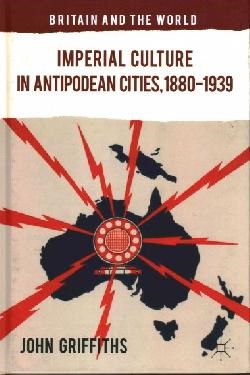
Editor-in-chief & Webmaster: Georges-Claude Guilbert
Book Review Editor: Molly O'Brien Castro
![]()
John Griffiths, Imperial Culture in Antipodean Cities, 1880-1939 (Basingstoke: Palgrave Macmillan, 2014). UK £65.00 (hardback), 96,95€, xiii and 306 pages, ISBN 978-1-137-38572-7—Trevor Harris, Université de Picardie Jules Verne, Amiens.
This study of Antipodean imperial culture, or the absence of it, is part of a much wider ongoing debate among historians about the British Empire: its capacity or incapacity to translate territorial presence into enthusiasm and loyalty to the imperial project. The debate has revealed that satisfactory definitions of that “project” are elusive: measuring commitment to the project is, therefore, equally difficult. Rather than attempting to gauge the strength of the imperial signal emitted from London–an approach which long dominated this literature–, John Griffiths, in keeping with other recent work, takes up a position in the “periphery” and calculates the strength of that signal as it arrives in the cities at the edge of the Empire.
The book is divided into seven chapters which deal, in turn, with
Antipodean urban reaction to imperial promptings in time of military
conflict (chapters 1 and 2); competition in those cities between imperialism
and North American culture (chapter 3); the degree of imperial enthusiasm
in the Antipodean press (chapter 4); how youth organisations, schools,
exhibitions and ceremonies did or did not keep the imperial flame
burning (chapters 5 and 6); and the success, or otherwise, of the
various imperial loyalty leagues (chapter 7). The whole book is well
documented: the author has consulted a very wide range of manuscript
sources—from official archives, but also all manner of personal
narratives and oral histories—and a wealth of secondary material,
all carefully marshalled through very full notes.
Griffiths rightly underlines at the outset that “there has never
been a consensus” [17] on the various triumphs or failures of
what J R Seeley, at the beginning of the period under discussion,
called “the expansion of England”, or what Sir Stephen
Tallents, in 1933, called “the projection of Britain”.
The range of views on this is wide, with John M. Mackenzie, argues
Griffiths, at the positive end of the scale, and Bernard Porter at
the other extreme. Griffiths himself, looking “from the ‘outside
in’ at the Empire project” [20], is keenly aware of the
difficulty of finding reliable new yardsticks when “post-colonialism
has itself colonised the realm of imperial history” [21] and
relativism, in a sense, is the new standard, the absence of norms
the new norm.
In general, Griffiths shows how the imperial sentiment in the urban
environment—in cities like Melbourne, Auckland, Christchurch
and Wellington—was constantly nuanced by the emergence of colonial
nationalism and how “the notion of imperial enthusiasm needs
to be qualified by reference to a sentiment based on a locally generated
patriotism” [40]: especially from the turn of the century onwards,
being greatly amplified as a direct consequence of the Great War.
Indeed, Antipodean cities, instead of “imperial”, became
“global”: Antipodean architecture, notably, from the 1880s
revealed the degree of American influence. Between the wars popular
culture in both Australia and New Zealand was increasingly Americanised,
and trade patterns became more diversified: the Empire remained relevant
only to the extent that it secured tangible benefits in terms of defence
or commerce. This was a hard-nosed, “instrumental approach to
the concept of Empire” [27]. All in all, the attitudes revealed
here show the extent to which belonging to the Empire was “an
identity that had rather shallow roots” [213]. Reaction to initiatives
from London was often muted, indifferent, even hostile, and increasingly
fuelled by the sentiment that Britain, in practice, was abandoning
the Empire, particularly following the Anglo-Japanese Alliance of
1902: Australia declined, for example, to participate in the Festival
of Empire in London in 1911.
The “localised patriotism” which Griffiths explores throughout
was perhaps to be expected: a process of differentiation through time
quite consistent with the Darwinian model both Britain and the colonies
espoused. Being part of a very large structure or system inevitably
means some parts of that structure/system are a long way from the
centre. The loyalty of these distant parts to the structure as a whole
must, logically, at least be expressed partly in terms of local pride:
it is not unnatural to express attachment to the whole through an
attachment to one of its parts. Nor is it necessarily illogical for
such local attachments to be more strongly felt—an attachment
to one’s family, friends and colleagues, rather than to some
distant personnel. And the inability to become enthused by such large
structures is a criticism which holds for all such structures, not
just the British Empire.
The relative speed with which this colonial indifference towards Britain
grew up, however, is more striking and Griffiths quotes a wealth of
material to illustrate the dying of the imperial light. The indifference
or disaffection charted here could, perhaps, also be seen as the logical
outcome of the British approach to Empire: colonies were established
and then fully expected to pay their own way and, whenever possible,
to fend for themselves. The pride in Greater Britain typical of the
latter part of the nineteenth century and, a fortiori, the late-nineteenth-century/early-twentieth
century schemes for imperial consolidation and federation were, historically,
more the exception than the rule, revealing Britain’s relative
decline, as Griffiths points out, and her frustration at losing control
of the emerging global system which she had, in many ways, set in
train. Indifference to Empire was also a sign of the political maturity
of the colonies themselves. Do such maturity and independence need
to be seen as a form of imperial failure? As Griffiths own evidence
shows, it is clear at various points that the recalcitrant imperial
citizens of the Antipodean cities saw themselves as in some sense
superior Britons, more British than the British: as one of the witnesses
quoted by Griffiths puts it in 1889, “we have many liberties
which the men of the old country still have to enjoy” [32].
Clearly some citizens in those southern cities felt their “local”
embodiment of “British” values was more likely to secure
their continuation.
John Griffiths recognises that while the “official” view
is well documented and can, therefore, be brought out quite clearly—whether
it be a case of enthusiasm for the Empire or of indifference—,
the unofficial view, the view, as it were, of the man on the Melbourne
omnibus, is much more difficult to obtain. This is potentially damaging
for Griffiths’s thesis, since much of the distancing of Empire
was, precisely, channelled through popular culture rather than through
elite sections of the population. But Griffiths sticks to his task
and carefully plots and quantifies the detail of pro-Empire, non-Empire
and anti-Empire sentiments across the “Tasman World”.
Some sections of the book carry less conviction than others: highlighting
the absence of any overtly imperialist motive among ANZAC soldiers
in 1914, for example, does not necessarily prove the absence of imperialist
sentiment among them. Many British recruits, too, like their Antipodean
counterparts, may well have been drawn to enlist by the excitement
of it all, by a sense of adventure, or simply by the prospect of some
regular pay for a change. But none of these motives proves the absence
of patriotism: support for a given cause may not be articulated clearly,
or at all. The strength of the soldiers’ local identity was
clearly a factor in Melbourne or Auckland. But similar “local
patriotisms” were common among Welsh, Scottish and Irish regiments,
as well as the strong regional identities which were visible in other
parts of Britain.
British “New Imperialism”, the relatively brief, largely unsuccessful attempt to “invent tradition”, or activate a loyalty to the imperial “centre”, was never more than a pipe dream, as the abortive plans for imperial federation show. The local and the unilateral became increasingly visible: in the attitude of the Dominions during the Chanak Crisis, for example, in Canadian diplomatic initiatives in 1923, in the short-lived, rather damp squib that was the Empire Marketing Board or, again, the often bad-tempered negotiations in the run-up to the signature of the Ottawa Agreements. This book sets itself the very difficult task of underlining the frequent lack of imperial sentiment in the attitudes and conduct of the urban populations of a number of cities in Australia and New Zealand. If the precise character and extent of that colonial realignment to the Empire are hard to pin down, the fact that colonies did distance themselves from Britain and adopt a constructively critical approach to their imperial heritage is not open to doubt. John Griffiths demonstrates this with great assurance, and should be congratulated on the sheer quantity and variety of evidence mobilised, and on the balanced approach which characterises the whole book.
© 2015 Trevor Harris & GRAAT


Senior
sub-editor: Hélène Tison
lntison@yahoo.fr

